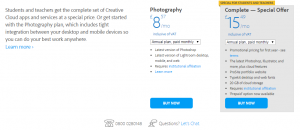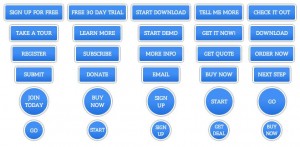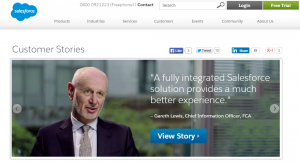Why Your Landing Page Matters
Online advertising has become a prominent force in an organisation’s marketing activities, with the standard approach seeing companies create adverts based on modelling the user’s needs and interests. However, there is a surprisingly low level of effort dedicated to what actually happens after an advert is clicked on (Becker et al, 2009).
Advertisers spend obscene amounts of money on buying traffic, but the effort that they devote to the landing page in which the user is sent to is often negligible (Ash, 2008). In many cases, strong adverts are created which encourage users to click, however, once users arrive on the landing page the bounce rate is high, which impacts negatively on the conversion rate (Zigmond et al, 2009).
Of course, it is difficult to answer why users do not respond to landing pages but there are certain tips that you can follow in order to create a successful landing page (Ash, 2008).
Firstly, what is a landing page and why is it important?
A landing page is any webpage on which an online visitor first arrives on their way to an important action that you would like them to take. The landing page may be part of your main website, or a stand-alone page designed specifically to receive traffic from a digital marketing campaign (Ash, Ginty & Page, 2012).
The ultimate goal of advertising is conversion, which is the transformation of a user who has clicked on the advert into a ‘buyer’ of the product or service which is being advertised (Becker et al, 2009). If a user clicks on your advert, but the landing page is ineffective in encouraging them to convert, this is going to ultimately affect your overall goal and waste advertising spend.
With this in mind, I have provided a combination of key points to help you ensure that your landing page is effective in encouraging users to complete the desired action on your webpage:
1) Keep it simple and relevant
The amount of information that users have access to online is vast (Cranor, 2012), therefore they are able to consciously or subconsciously avoid the information that they do not find relevant. If a user lands on your page and is faced with an overload of information, it is likely to decrease the perceived quality of the message that you are conveying, and defer them away from completing the desired action (Salyer, 2013).
An often forgotten, but fundamental aspect to ensure landing page success is relevancy. One of the main reasons that organisations fail in their online advertising efforts is that their landing page does not deliver what the advert promises (Ash, 2008).
That is why it is important to make sure that your landing page is simple and relevant. Ensure that it contains a minimalistic level of relevant content in order to match the needs of the user and defer away from creating an information overload.
As an example, let’s take a look at an advert on Facebook and the landing page:
Facebook advert:
Landing page:
The landing page created by Adobe is an effective example of a landing page which contains minimalist information which is not only relevant to the advert upon which a user clicks, but also does not require a large amount of the users time in order to absorb the level of information
2) Have a clear call-to-action
Clear call-to-actions are a fundamental aspect in advertising, as users are more likely to act when they are prompted to do so (Loomer, 2014). If you do not make it obvious what you want the user to do when they land on your page, it is likely to defer them away from completing the desired action.
The type of call-to-action is dependent on the product/service that you are advertising, so make sure that it is relevant. For example, in the retail sector it could be ‘Buy Now’, whereas in the public sector it could be ‘Find Out More’ or ‘Register Your Interest’.
3) Do not ask for a large amount of information
As online advertising increases, users are far more in control of the choices that they make in relation to the actions that they choose to take (Salyer, 2013). Their patience for completing long-winded actions is deteriorating, therefore if they perceive that performing an action is going to take a large amount of time, they are likely to defer away from doing so (Rauniar et al, 2014).
This is related to the Davis (1989) Technology Acceptance Model, which although may be viewed as a dated model, still remains a useful source for organisations seeking to understand user acceptance of technology (Park, 2009).
Source: Davis (1989)
The main aspect which can be utilised for understanding landing page success is the perceived ease of use. This is the degree to which the prospective user expects the action to be free of effort (Sago, 2013). The lower the level of perceived effort, the more likely it is that the user will convert, so make sure that you only ask for the information that you really need.
4) Split test
It is difficult to understand why users do or do not respond to a landing page (Ash, 2008), but split testing your landing pages can help determine the type of content which is likely to encourage your audience to convert.
Every user is different, which means that their preferred choice of content also differs. Create multiple landing pages with different content in order to distinguish which best resonate with your audience.
For more information on the importance of split testing please find my previous blog here.
5) Communicate the benefits & include testimonials
Online users today are more sceptical than ever, meaning that the most difficult challenges that organisations face are communicating why a user should choose their product/service rather than a competitors and what makes their offering distinctive and unique (McKenna, 2006).
The problem is that most organisations believe that focusing primarily on factual information is sufficient enough in encouraging the user to convert (Kim & Fesenmaier, 2008). What many do not realise is that once the user has landed on the page, it is important that the benefits of converting are also communicated. This is because online users are primarily interested in completing actions which are going to provide them with some form of benefit, whether it be tangible or intangible (Cataneda, Rodriguez & Luque, 2009).
An effective way of communicating the benefits is through implementing testimonials. A testimonial is a written form of communication from a user about your product/service offering which states what is special about your firm and your firm’s offering. The power of a testimonial can unlock the subconscious minds of your audience and draw them in by providing evidence of success, building trust and providing credibility and reassurance (McKenna, 2006).
Below is an example of a testimonial taken from Salesforce. The aspect which is particularly strong is how the firm has referred to its testimonials as ‘customer stories’. This method creates emotional impact and indicates that the organisation care about the difference that their system makes to customers.
Source: Salesforce (2015)
To look further at the testimonials created by Salesforce for thoughts and ideas click here.
6) Include links to social media
Users are increasingly seeking to engage with brands on social media (Schawbel, 2015), so make sure that you include links to your social media sites in order to encourage users to connect with you, thus increasing your social media fan base.
Utilise your social media links not just by encouraging users to become a member of your fan base, but also by encouraging them to share your product/service offering with their peers. By tapping into online communities, your audience reach is broadened and the opportunity of online word-of-mouth is created (Jahn & Kunz, 2012).
Concluding Points
The points discussed above are predominantly focused on the goal of conversions; however, what is also important in your digital marketing efforts is creating awareness and engagement. Many businesses focus solely on getting users to convert, with a lack of understanding in regards to the importance of creating online awareness.
It should be understood that an effective landing page is not enough for success, it is also very much about a user’s attitude towards the product/service, brand, brand behaviour and the firm itself (Cataneda, Rodriguez & Luque, 2009). You may have strong advertising and an effective landing page, but if a user is not aware of your brand or has a negative perception, they are likely to defer away from converting, so make sure that you focus just as much attention on creating a positive online brand presence.
To determine the effectiveness of your landing page, ask yourself the following questions which can be found in an interesting Forbes article here.
For further reading on the subject, please see the references below:
Ash, T. 2008, Start Thinking About LANDING PAGE OPTIMIZATION, Penton Media, Inc., Penton Business Media, Inc. and their subsidiaries, Rockville [accessed 09 April 2015]
Ash, T., Ginty, M., & Page, R. (2012). Landing page optimization: the definitive guide to testing and tuning for conversions. John Wiley & Sons.
Becker, H; Broder, A; Gabrilovich, E; Josifovski, V; Pang, B (2009) ‘What happens are an Ad Click? Quantifying the impact of landing pages in web advertising’ < http://www.cs.technion.ac.il/~gabr/publications/papers/Becker2009WHA.pdf> [accessed 18 April 2015]
Castañeda, J.A., Rodríguez, M.A. & Luque, T. 2009, “Attitudes’ hierarchy of effects in online user behaviour”, Online Information Review, vol. 33, no. 1, pp. 7-21.
Cranor, L.F. 2012, “Can Users Control Online Behavioral Advertising Effectively?”, IEEE Security&Privacy Magazine, vol. 10, no. 2, pp. 93-96.
Davis, F.D. (1989). Perceived usefulness, perceived ease of use, and user acceptance of information technology. MIS Quarterly, 13(3), 331-340
Jahn, B. & Kunz, W. 2012, “How to transform consumers into fans of your brand”, Journal of service management, vol. 23, no. 3, pp. 344-361.
Kim, H. & Fesenmaier, D.R. 2008, “Persuasive Design of Destination Web Sites: An Analysis of First Impression”, Journal of Travel Research, vol. 47, no. 1, pp. 3-13.
Loomer (2014) Facebook call-to-action buttons: create for ads and organic posts [Online] < http://www.jonloomer.com/2014/02/10/facebook-call-to-action-buttons/> [accessed 18 April 2015]
McKenna, P.J. 2006, “Testimonials as a differentiation tool”, Of Counsel, vol. 25, no. 11, pp. 5
Park, S. Y. (2009). An Analysis of the Technology Acceptance Model in Understanding University Students’ Behavioral Intention to Use e-Learning. Educational Technology & Society, 12 (3), 150–162.
Sago, B (2013) ‘Factors influencing social media adoption & frequency of use: An examination of Facebook, Twitter, Pinterest and Google +’ [Online], Vol 3 (Issue 1) [accessed 14 April 2015]
Salesforce (2015) Customer Stories [Online] < http://www.salesforce.com/uk/customers/> [accessed 14 April 2015]
Salyer, G (2013) ‘Information Overload: The effects of advertising avoidance on brand awareness in an online environment’ < http://web02.gonzaga.edu/comltheses/proquestftp/Salyer_gonzaga_0736M_10263.pdf> [accessed 18 April 2015]
Schawbel, D. (2015). 10 New Findings About The Millennial Consumer. Available: http://www.forbes.com/sites/danschawbel/2015/01/20/10-new-findings-about-the-millennial-consumer/. Last accessed 20th Jan 2015.
Zigmond, D, Sundar, D, Interian, Y, Navemiouk, I (2009) ‘Measuring advertising quality based on audience retention’ Journal of Advertising Research [Online], Vol 49 (Issue 4) [accessed 09 April 2015]




